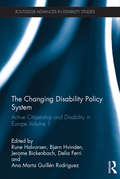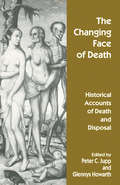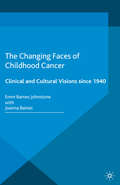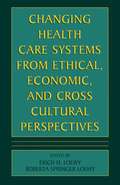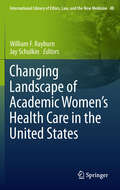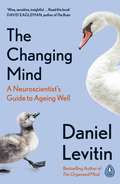- Table View
- List View
Changes in the Brain: Impact on Daily Life
by Nancy D. Chiaravalloti Yael GoveroverThis informative text details the many changes in everyday life as the result of injury, illness, or aging affecting the brain. Experts across brain-related fields trace mechanisms of conditions such as Parkinson’s disease, TBI, and dementia as they impact regions of the brain, and resulting cognitive, emotional, sensory, and motor impairments as they contribute to deficits in personal and social functioning. In addition to symptoms and behaviors associated with insults to the brain (and the extent to which the brain can adapt or self-repair), chapters provide cogent examples of how societal and cultural expectations can shape the context and experience of disability. The book’s focus on everyday activities brings new clarity to diverse links between symptoms and diagnosis, brain and behavior. Included in the coverage: ·The aging brain and changes in daily function. ·Stroke: impact on life and daily function. ·Traumatic brain injury (TBI) and the impact on daily life. ·Everyday life with cancer. ·Real-world impact of HIV-associated neurocognitive impairment. ·Disability and public policy in America. ·Living after brain changes, from the patient’s perspective. Rich in empirical data and human insight, Changes in the Brain gives neuropsychologists, clinical psychologists, clinical social workers, and rehabilitation nurses a robust new understanding of the daily lives of patients, both in theory and in the real world.
Changing Aspects in Stroke Surgery: Aneurysms, Dissection, Moyamoya angiopathy and EC-IC Bypass (Acta Neurochirurgica Supplement)
by Yasuhiro Yonekawa Tetsuya Tsukahara Anton Valavanis Nadia KhanWhat is arterial dissection? What is Moyamoya angiopathy? What is the state-of-the-art of AVM treatment? Readers will find answers to these questions in this book. They will also be informed about the state-of-the-art treatment in the daily stroke therapy.
Changing Clinical Care: Experiences and Lessons of Systematisation (Radcliffe Ser.)
by Andrew Gray Pieter Degeling Abayomi McEwen"Changing Clinical Care" adopts a fresh, nursing and patient-centred approach to systemisation to aid patients and their carers. The evidence-based methodology outlines real-world experiences in various sectors of healthcare including primary care, cardiac services, general surgery, and care of long term conditions. It sheds light on possible difficulties and examines the key lessons learnt in providing effective systemisation including common problems, pit-falls and effective solutions. It includes high profile prologues by Dame Carol Black, (Past President, Royal College of Physicians of England) Dr David Colin-Thome (National Clinical Director for Primary Care, Department of Health, England) and Professor Alison Kitson (Executive Director, Royal College of Nursing). This book is ideal for all healthcare professionals interested in systemising the delivery of care. It is also of great interest to healthcare policy makers and shapers, and academics and researchers.
Changing Clinical Care: Experiences and Lessons of Systematisation
by Andrew Gray Pieter Degeling Abayomi McEwen"Changing Clinical Care" adopts a fresh, nursing and patient-centred approach to systemisation to aid patients and their carers. The evidence-based methodology outlines real-world experiences in various sectors of healthcare including primary care, cardiac services, general surgery, and care of long term conditions. It sheds light on possible difficulties and examines the key lessons learnt in providing effective systemisation including common problems, pit-falls and effective solutions. It includes high profile prologues by Dame Carol Black, (Past President, Royal College of Physicians of England) Dr David Colin-Thome (National Clinical Director for Primary Care, Department of Health, England) and Professor Alison Kitson (Executive Director, Royal College of Nursing). This book is ideal for all healthcare professionals interested in systemising the delivery of care. It is also of great interest to healthcare policy makers and shapers, and academics and researchers.
Changing Dietary Patterns, Indigenous Foods, and Wild Foods: In Relation to Wealth, Mutual Relations, and Health in Tanzania
by Kumiko Sakamoto Lilian Daniel Kaale Reiko Ohmori Tamahi KatoThis book presents different dietary patterns, some utilizing wild foods and others facing drastically changing dietary patterns, and shows their implications for health in terms of wealth, mutual assistance, food sufficiency and food diversity. The book examines these globally important issues through a case study of Tanzania. Using a novel methodology based on a global standard quality of life indicator, the book sheds light on the relationship between wild food intake and health in Tanzania. Descriptive case studies illustrate the impact of various food patterns and wild food intake on human health. It also highlights the divergence between food production sufficiency and food diversity. It then discusses the influence of wealth, mutual relations, and methods of food access. Finally, the book concludes with recommendations for maintaining good health in various environments. The intended readers of this book are academics and professionals in the fields of development, nutrition, and environment in East Africa. These include, but are not limited to, regional and district personnel who are actively engaged in development, relevant ministries of food and agriculture, and international organizations such as FAO, UNICEF, UNDP, and UNEP. In the academic field, students and researchers in international studies, development studies, African studies, social studies, cultural studies, nutrition, agriculture, and environmental studies are targeted.
The Changing Disability Policy System: Active Citizenship and Disability in Europe Volume 1 (Routledge Advances in Disability Studies)
by Rune Halvorsen Bjø Hvinden Jerome Bickenbach Delia Ferri Ana Marta Guillén RodriguezBeing an ‘active citizen’ involves exercising social rights and duties, enjoying choice and autonomy, and participating in political decision-making processes which are of importance for one’s life. Amid the new challenges facing contemporary welfare states, debate over just how ‘active’ citizens can and ought to be has redoubled. Presenting research from the first major comparative and cross-national study of active citizenship and disability in Europe, this book analyses the consequences of ongoing changes in Europe – what opportunities do persons with disabilities have to exercise Active Citizenship? The Changing Disability Policy System: Active Citizenship and Disability in Europe Volume 1 approaches the conditions for Active Citizenship from a macro perspective in order to capture the impact of the overall disability policy system. This system takes diverse and changing forms in the nine European countries under study. Central to the analysis are issues of coherence and coordination between three subsystems of the disability policy system, and between levels of governance. This book identifies the implications and policy lessons of the findings for future disability policy in Europe and beyond. It will appeal to policymakers and policy officials, as well as to researchers and students of disability studies, comparative social policy, international disability law and qualitative research methods.
The Changing Disability Policy System: Active Citizenship and Disability in Europe Volume 1 (Routledge Advances in Disability Studies)
by Rune Halvorsen Bjørn Hvinden Jerome Bickenbach Delia Ferri Ana Marta Guillén Rodriguez Eva KartchavaBeing an ‘active citizen’ involves exercising social rights and duties, enjoying choice and autonomy, and participating in political decision-making processes which are of importance for one’s life. Amid the new challenges facing contemporary welfare states, debate over just how ‘active’ citizens can and ought to be has redoubled. Presenting research from the first major comparative and cross-national study of active citizenship and disability in Europe, this book analyses the consequences of ongoing changes in Europe – what opportunities do persons with disabilities have to exercise Active Citizenship? The Changing Disability Policy System: Active Citizenship and Disability in Europe Volume 1 approaches the conditions for Active Citizenship from a macro perspective in order to capture the impact of the overall disability policy system. This system takes diverse and changing forms in the nine European countries under study. Central to the analysis are issues of coherence and coordination between three subsystems of the disability policy system, and between levels of governance. This book identifies the implications and policy lessons of the findings for future disability policy in Europe and beyond. It will appeal to policymakers and policy officials, as well as to researchers and students of disability studies, comparative social policy, international disability law and qualitative research methods.
The Changing Face of Death: Historical Accounts of Death and Disposal
by Glennys Howarth Peter C. JuppThe taboo on death is at last breaking down. There is far greater receptivity to informed discussion about death and dying. Dying with dignity is one major issue: euthanasia and the 'natural death movement' are the latest stages in a debate first stimulated by the hospice movement. Media treatment of the bereaved, especially after disasters, has attracted some adverse criticism, yet after the decline of traditional customs of mourning, people seek new models of acceptable behaviour at a time of death. The book argues that attitudes to death and to disposal are culturally formed and examines the factors in the formation and decline of such attitudes by analysing specific issues over four centuries of death.
The Changing Face of Medical Education (Radcliffe Ser.)
by Cavenagh Leinster PenelopeThe past 50 years - and even the past 20 years - have seen almost revolutionary change in medical education, which has emerged as a distinct discipline during that time. The curriculum to be covered, the most effective learning and teaching methods, and what kind of professional (and indeed person) medical education is intended to produce, how success can best be assessed and - not least - the make-up of students and teachers themselves have all changed enormously. This unique text draws together a wide variety of perspectives and focuses in particular on the experiences of one of the U.K.'s newer medical schools. It examines the key changes that have shaped the field, its practitioners and its students, presenting unique perspectives on both its history and on the current state of the art. This book is rewarding and informative reading for educationalists, academics, sociologists and researchers in medical history and education. 'The education of our healthcare professionals is one of the most important challenges for higher education. In setting up the new medical school at UEA we recognised this challenge and set out to develop a method of teaching and learning that put the student and their learning needs at the centre of the curriculum. The results of this and some of the developments that have emerged from those early days are outlined in this book.' - from the Foreword by Shirley Pearce
The Changing Face of Medical Education
by Cavenagh Leinster PenelopeThe past 50 years - and even the past 20 years - have seen almost revolutionary change in medical education, which has emerged as a distinct discipline during that time. The curriculum to be covered, the most effective learning and teaching methods, and what kind of professional (and indeed person) medical education is intended to produce, how success can best be assessed and - not least - the make-up of students and teachers themselves have all changed enormously. This unique text draws together a wide variety of perspectives and focuses in particular on the experiences of one of the U.K.'s newer medical schools. It examines the key changes that have shaped the field, its practitioners and its students, presenting unique perspectives on both its history and on the current state of the art. This book is rewarding and informative reading for educationalists, academics, sociologists and researchers in medical history and education. 'The education of our healthcare professionals is one of the most important challenges for higher education. In setting up the new medical school at UEA we recognised this challenge and set out to develop a method of teaching and learning that put the student and their learning needs at the centre of the curriculum. The results of this and some of the developments that have emerged from those early days are outlined in this book.' - from the Foreword by Shirley Pearce
The Changing Face of Medicine: Women Doctors and the Evolution of Health Care in America (The Culture and Politics of Health Care Work)
by Ann K. Boulis Jerry A. JacobsThe number of women practicing medicine in the United States has grown steadily since the late 1960s, with women now roughly at parity with men among entering medical students. Why did so many women enter American medicine? How are women faring, professionally and personally, once they become physicians? Are women transforming the way medicine is practiced? To answer these questions, The Changing Face of Medicine draws on a wide array of sources, including interviews with women physicians and surveys of medical students and practitioners. The analysis is set in the twin contexts of a rapidly evolving medical system and profound shifts in gender roles in American society. Throughout the book, Ann K. Boulis and Jerry A. Jacobs critically examine common assumptions about women in medicine. For example, they find that women's entry into medicine has less to do with the decline in status of the profession and more to do with changes in women's roles in contemporary society. Women physicians' families are becoming more and more like those of other working women. Still, disparities in terms of specialty, practice ownership, academic rank, and leadership roles endure, and barriers to opportunity persist. Along the way, Boulis and Jacobs address a host of issues, among them dual-physician marriages, specialty choice, time spent with patients, altruism versus materialism, and how physicians combine work and family. Women's presence in American medicine will continue to grow beyond the 50 percent mark, but the authors question whether this change by itself will make American medicine more caring and more patient centered. The future direction of the profession will depend on whether women doctors will lead the effort to chart a new course for health care delivery in the United States.
The Changing Face of Volunteering in Hospice and Palliative Care
by Ros Scott and Steven HowlettVolunteers have a long been involved in supporting the delivery of palliative care. Indeed in some countries, the range and quality of hospice and palliative care services depends on the involvement of volunteers. Hospice and palliative care services and volunteering are changing. As society develops, so too does volunteering. Volunteers have growing expectations of organizations, and increasingly seek roles that meet their needs and aspirations, rather than fitting in with organizational approaches. As hospice and palliative care services experience increasing and changing demands for their services due to aging populations with complex healthcare needs, we need to recognize that volunteers have a vital role to play in supporting the delivery of services of the future. The Changing Face of Volunteering in Hospice and Palliative Care explores the complex phenomenon that is volunteering in hospice and palliative care in different countries. It considers how and why volunteering is changing, through the contributions of authors from Western and Eastern Europe, North America, Australia, Africa, and India. It reflects on the influence of culture and organisational contexts, in addition to management approaches, legislative, and political influences, highlighting factors that contribute to the success of volunteering. Contributing to knowledge and understanding in the field of volunteering in hospice and palliative care internationally, this book highlights the factors that contribute to the success of volunteering models, allowing readers to see possibilities for change and find new ideas for innovative practice in their own setting.
The Changing Face of Volunteering in Hospice and Palliative Care
Volunteers have a long been involved in supporting the delivery of palliative care. Indeed in some countries, the range and quality of hospice and palliative care services depends on the involvement of volunteers. Hospice and palliative care services and volunteering are changing. As society develops, so too does volunteering. Volunteers have growing expectations of organizations, and increasingly seek roles that meet their needs and aspirations, rather than fitting in with organizational approaches. As hospice and palliative care services experience increasing and changing demands for their services due to aging populations with complex healthcare needs, we need to recognize that volunteers have a vital role to play in supporting the delivery of services of the future. The Changing Face of Volunteering in Hospice and Palliative Care explores the complex phenomenon that is volunteering in hospice and palliative care in different countries. It considers how and why volunteering is changing, through the contributions of authors from Western and Eastern Europe, North America, Australia, Africa, and India. It reflects on the influence of culture and organisational contexts, in addition to management approaches, legislative, and political influences, highlighting factors that contribute to the success of volunteering. Contributing to knowledge and understanding in the field of volunteering in hospice and palliative care internationally, this book highlights the factors that contribute to the success of volunteering models, allowing readers to see possibilities for change and find new ideas for innovative practice in their own setting.
The Changing Faces of Childhood Cancer: Clinical and Cultural Visions since 1940 (Science, Technology and Medicine in Modern History)
by Joanna Baines Emm Barnes JohnstoneThis book traces the development of British answers to the problem of childhood cancer. The establishment of the NHS and better training for paediatricians, meant children were given access to experimental chemotherapy, sending cure rates soaring. Children with cancer were thrust into the spotlight as individuals' stories of hope hit the headlines.
The Changing Federal Role in U.S. Health Care Policy
by Jennie Jacobs KronenfeldHealth care in the United States at the end of the 20th century occupies a completely different place in the economy, in the public consciousness, and in its impact on government, than it did at the beginning of the century, or even in the early years of the Clinton Administration. Health care is now a multi-billion dollar industry; one that consumes more than 15 percent of the nation's GNP. Citizens now regard health care as essential to the quality of their lives, and a steady stream of new medications and procedures point to ways to extend the lives of our aging population and restore those injured on or off the job. At the same time, the changing patterns of health care have stirred a national debate over the growth of managed care and the role that government can play in providing solid health care standards—a medical safety net—within tightening budgetary restraints. This book explores the role of the federal government in health care policy development from the years of the Founding Fathers to the present.Kronenfeld reviews the key features of the American health care system, its infrastructure, and federal legislative process and outcomes in the health care arena. The current situation in health care is examined, with particular attention given to the attempt at major reform in the first Clinton administration, and to the modest changes that were ultimately passed. She closes with an examination of the future of health care and the role of government, emphasizing how current health care issues and concerns may set the stage for a changed federal role in funding and delivery of health care services in the next century. This comprehensive examination of the role of government in the health care system will be of great interest to students and researchers of public policy and the social aspects of American health care.
Changing Health Care Systems from Ethical, Economic, and Cross Cultural Perspectives
by Erich E. H. LoewyThis volume is the result of a conference sponsored by the Medical Alumni Association of the University of California, Davis and held in Sacramento, California, in January, 2000, The purpose of this conference was to examine the impact ofvarious health care structures on the ability of health care professionals to practice in an ethically acceptable manner. One of the ground assumptions made is that ethical practice in medicine and its related fields is difficult in a setting that pays only lip service to ethical principles. The limits of ethical possibility are created by the system within which health care professionals must practice. When, for example, ethical practice necessitates—as it generally does—that health care professionals spend sufficient time to come to know and understand their patients’ goals and values but the system mandates that only a short time be spent with each patient, ethical practice is made virtually impossible. One of our chief frustrations in teaching health care ethics at medical colleges is that we essentially teach students to do something they are most likely to find impossible to do: that is, get to know and appreciate their patients’ goals and values. There are other ways in which systems alter ethical possibilities. In a system in which patients have a different physician outside the hospital than they will inside, ethical problems have a different shape than if the treating physician is the same person.
The Changing Hospital Industry: Comparing Not-for-Profit and For-Profit Institutions (National Bureau of Economic Research Conference Report)
by David M. CutlerIn recent years, the hospital industry has been undergoing massive change and reorganization with technological innovations and the spread of managed care. As a result, the total number of hospitals countrywide has been declining, and a growing number of not-for-profit hospitals have converted to for-profit status. These changes raise two fundamental questions: What determines a hospital's choice of for-profit or not-for-profit organizational form? And how does that form affect patients and society? This timely volume provides a factual basis for discussing for-profit versus not-for-profit ownership of hospitals and gives a first look at the evidence about new and important issues in the hospital industry. The Changing Hospital Industry: Comparing Not-for-Profit and For-Profit Institutions will have significant implications for public-policy reforms in this vital industry and will be of great interest to scholars in the fields of health economics, public finance, hospital organization, and management; and to health services researchers.
Changing Human Behaviour to Enhance Animal Welfare (CABI Concise)
by Heather Bacon Professor Cathy M Dwyer Suzanne Rogers Jo White Beth Ventura Erica Hogstad Fjæran Melissa Liszewski Tamsin Coombs Fritha Langford Sara Shields Priya Motupalli Mabel Aworh-Ajumobi Vijay Pal Singh Sujoy Khanna Ashleigh Brown Shereene Williams Laura SkippenBridging the gap between the science of animal welfare, the animals and their owners, this book gives essential advice to practitioners worldwide on how to improve the welfare of all animals.
Changing Innovation in the Pharmaceutical Industry: Globalization and New Ways of Drug Development
by Dr Andre JungmittagThe internationalization of research and technology is one key component of the globalization of trade and business, with potentially major impacts on patterns of economic development and public policies worldwide. Although certain aspects of this internationalization trend are well documented, and some effects can be quantified, the overall processes are extremely complex and the outcomes are highly uncertain. The existence of the phenomenon is generally accepted, but its importance and the trends are currently the topic of a lively debate. This study on "New Ways in Drug Development in Pharmaceuticals" is part of a three year project which aims at investigating how new concepts of industrial knowledge creation are implemented in the different environ ments of the innovation systems of the United States and Germany. The main focus of the overall project is a series of case studies of innovation practice in different national and sectoral contexts. The following sectors and technological fields are investigated: pharmaceuticals and new ways in drug development by the Fraunhofer Institute for Systems and Innovation Research (ISI), advanced materials by the University Hohenheim, Insti tute of International Management and Innovation (Alexander Gerybadze), financial services and home banking by the Massachusetts Institute of Tech nology (MIT), Center for Industrial Performance (Richard Lester) and the Sloan School of Management (Edward Roberts). Financially the project was supported by the German-American Academic Council, the German Federal Minstry of Education, Science Research and Technology and the Fraunhofer Society.
Changing Landscape of Academic Women's Health Care in the United States (International Library of Ethics, Law, and the New Medicine #48)
by William F. F. Rayburn and Jay SchulkinSince 2005 a dozen states and more than 15 specialties have reported a physician shortage or anticipate one in the next few years. This anticipated shortage and a worsening of physician distribution are compounded by a projected increased demand for women’s healthcare services.Women’s healthcare is particularly vulnerable, because the obstetrician-gynecologist workforce is aging and is among the least satisfied medical specialists. Furthermore, fellowship training in women’s healthcare in internal medicine and in maternal child health in family and community medicine involves only a small portion of general internists and family physicians.In response to this challenge, the Association of American Medical Colleges called for an expansion of medical schools and graduate medical education enrollments. As we cope with significant and rapid changes in organizations and reimbursement, academic departments of obstetrics and gynecology, family and community medicine, and internal medicine have opportunities to create a unified women’s health curriculum for undergraduate students, share preventive health and well-woman expertise in training programs, provide improved continuity of care, instill concepts of lifelong learning to our graduates, and better develop our research programs. This volume’s chapters focus on strategic planning on behalf of academic faculty who will train the anticipated additional load of students, residents, and fellows in women’s healthcare. -changing demographics of faculty -expanding roles of clinician educators -physician investigators and their future -the hidden value of part-time faculty -faculty salaries -required skillsets of academic leaders -the meaning of tenure and faculty satisfaction and retention.Recommendations presented here from authors with distinguished leadership skills indicate a consensus, but not unanimity. In furthering these goals, we summarize in the final chapter our collective expertise and offer ways to implement recommendations to better prepare for tomorrow’s needs in academic women’s healthcare.
The Changing Mind: A Neuroscientist's Guide to Ageing Well
by Daniel LevitinTHE NEW YORK TIMES BESTSELLER'Everyone we know needs this remarkable book ... An essential book for the rest of your life' Daniel H. Pink, author of When and Drive'The secrets of ageing well ... a serious, evidence-based guide to what really works and why' Sunday Times____________________________________________ We have long been encouraged to think of old age as synonymous with deterioration. Yet, recent studies show that our decision-making skills improve as we age and our happiness levels peak in our eighties. What really happens to our brains as we get older?More of us are living into our eighties than ever before. In The Changing Mind, neuroscientist, psychologist and internationally-bestselling author Daniel Levitin invites us to dramatically shift our understanding of growing older, demonstrating its many cognitive benefits. He draws on cutting-edge research to challenge common and flawed beliefs, including assumptions around memory loss and the focus on lifespan instead of 'healthspan'.Levitin reveals the evolving power of the human brain from infancy to late adulthood. Distilling the findings from over 4000 papers, he explains the importance of personality traits, lifestyle, memory and community on ageing, offering actionable tips that we can all start now, at any age.Featuring compelling insights from individuals who have thrived far beyond the conventional age of retirement, this book offers realistic guidelines and practical cognition-enhancing tricks for everyone to follow during every decade of their life. This is a radical exploration of what we all can learn from those who age joyously.
The Changing Nervous System: Neurobehavioral Consequences Of Early Brain Disorders
by Sarah H. Broman Jack M. FletcherThe Changing Nervous System: Neurobehavioral Consequences of Early Brain Disorders
by Sarah H. Broman Jack M. FletcherThis book provides an integrated review of current research on neural plasticity and reorganization after early cerebral insults. Addressing both animal studies and a variety of diverse clinical populations, including children with congenital brain malformations, focal lesions, autism, and pervasive developmental disorders, this book summarizes many of the major advances on neural plasticity made in these areas over the past several years. Characterized by a broad historical perspective including contributions from some of the earliest researchers on environmental factors and brain organization, the book advances the reader form the laboratory to application in several human populations. Many of the components of the book explicitly address relationships of animal and human models, showing that the laboratory and the clinic are overlapping settings, not isolated chambers as they are often perceived. The understanding of neural plasticity and both biological and environmental factors that influence brain reorganization after early cerebral insult has major implications for treatment. The book outlines many of the potential applications for treatment of early brain disorders. The contributors include basic neuroscientists, cognitive neuroscientists, and clinician-researchers who work together to bridge gaps among disciplines. The book should facilitate collaborative research and applications in the critical areas of neural plasticity and brain reorganization. Advancement of knowledge of factors that prevent and enhance brain reorganization after early cerebral insult is a key to unraveling the mysteries of the developmental disorders characteristic of children and which influence their development through adulthood.
Changing Paradigms in the Management of Breast Cancer
by Marissa Howard-McNattThis text is designed to present a comprehensive and state-of the-art approach to the management of breast cancer within the fields of surgery, medical oncology, and radiation oncology. Sections address changes in these fields. These areas include breast imaging, management of the axilla, atypical breast lesions, surgical margins, new techniques in breast reconstruction, and nipple sparing and contralateral mastectomies. Subsequent chapters focus on issues in medical oncology including, triple negative breast cancer and metastatic breast disease. New paradigms in radiation oncology are examined. Breast cancer treatment in the elderly and in young women, and genetic risk in breast cancer management is also be discussed. Written by experts in their field, each of these sections addresses advances and changes in the field. A brief review of the existing literature addressing the particular topic follows in each section. The text concludes with chapters on pathological issues and advances in radiation oncology. As access to a comprehensive multidisciplinary resource such as this is currently limited in the literature, Changing Paradigms in the Management of Breast Cancer represents the first single source to provide information on advances and outcomes for the physician caring for breast cancer patients in a multidisciplinary setting.
The Changing Role of Medical Students - E-Book
by Jeni Harden Ronald M HardenThe changing role of the student – from consumer and client to partner in the learning process – is arguably the most important development in medical education in the past two decades. The Changing Role of Medical Students takes a comprehensive look at what this means for educators, researchers, administrators, and all stakeholders across health care education. Written by Ronald M. Harden, author of Essential Skills of the Medical Teacher and Eight Roles of the Medical Teacher, and his daughter Jeni Harden, a social scientist with extensive experience teaching both medical and social science students – this book aims to inform and inspire. From the philosophical to the pragmatic, students will better understand the multifaceted roles they can and should embrace in their own education, teachers and trainers will learn how to actively engage students in this process, and administrators will gain insights for how to review and evolve the role of students in their organisations for maximum effectiveness. Describes the seven roles of the student as an active participant in the delivery of the education programme as: a professional; a facilitator of their own learning; an information processor; a curriculum collaborator; an assessor; a teacher; and as a scholar. Contains short reflective narratives and anecdotes from the student perspective. Ideal for students, teachers and trainers, curriculum evaluators and developers, faculty and admissions, as well as researchers and managers throughout the health care education system. eBook version included with purchase. Your eBook allows you to access, electronically, all of the text, figures, and references from the book.




